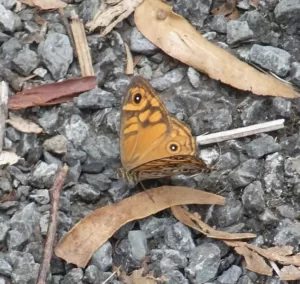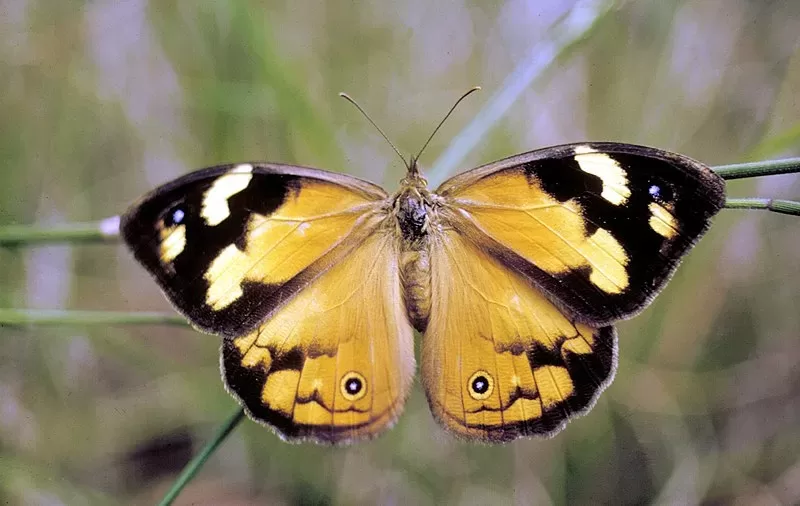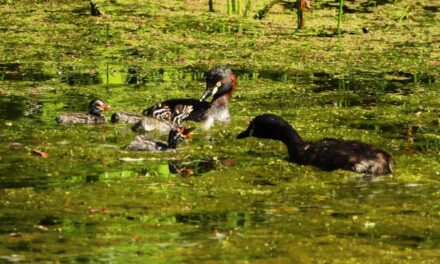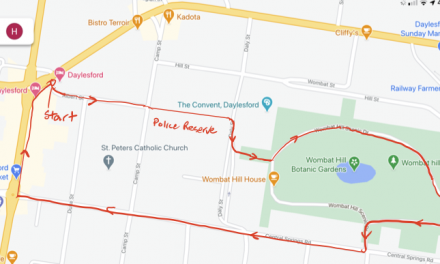Tanya Loos
At the moment your walks may be accompanied by clouds of Common Brown Butterflies (Heteronympha merope) which flutter and then land as you pass through the areas where they are resting and feeding.
These butterflies are much prettier than the drab name suggests! The males and females look quite different. The males are smallish, and with an indistinct pattern of fawn coloured circles and spots. The females are larger than the males, with wings a bold pattern of black and gold and brown.

Male Common Brown Butterfly. (Photo: Wikimedia Commons)
You may notice a lot of the males are looking very shabby indeed, with the edges of their wings fraying and their colour fading as their wing scales rub away. This is due to their quite amazing life history.
After mating, all the males die. The stronger and more robust females then enter the next phase of their lives for the next few months. They enter a form of summer hibernation, known as aestivation. Aestivation means the females can avoid the heat waves and lack of moisture during a harsh summer. (Remember those?!)
A period of aestivation is also a very clever strategy which ensures the eggs are laid by the female after the autumn rains arrive. The rains ensure that there is fresh green grass for their caterpillars.
Unlike many butterfly species which use only one plant for their caterpillars, Common Browns feed on a wide variety of grasses. They like native grasses such as spear grasses (Austrostipa), tussock grasses (Poa), and Kangaroo Grass ( Themeda triandra). Surprisingly they feed on introduced grasses as well! Brown-top bent (Agrostis) and Panic Veldt (Ehrharta) are on the menu.
The cool survival skills of these butterflies start young. When the eggs hatch at the base of the grass tussock, the babies eat the egg shells. Then, two things may happen. In a first smaller group, the young move away and immediately start eating. The other group, which is most of the young hatchlings remain still and go into a kind of torpor until they feel rain. If they do not receive rain they starve to death after 2-4 weeks! Brutal! If they do feel raindrops they begin to feed, or travel to seek out green growing grass tips. This way there are two cohorts of young caterpillars, thus ensuring at least some caterpillars may survive even if it is a drought year.
I have never seen a Common Brown caterpillar – and it turns out that is usual for the species. They are very shy, spending the day hiding at the base of their favourite grass and then coming out to feed at night. They are green in colour with some spots and stripes.
By next spring the caterpillars are nice and fat, and it is time for the caterpillar to turn into a pupa. They are most often in a silk-lined cavity in the soil at the base of their food plant. After a month or two – the adult butterfly emerges to repeat the process!
Tanya Loos is a local naturalist, author and environmental consultant who loves to work in the environmental not-for-profit sector. She is the author of “Daylesford Nature Diary” available from her website or from Paradise Books in Vincent Street, Daylesford.
Have you got any nature questions for Tanya? Send them in!











